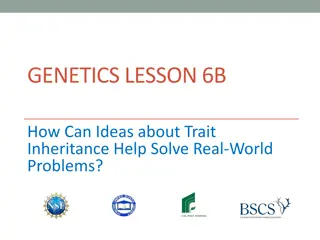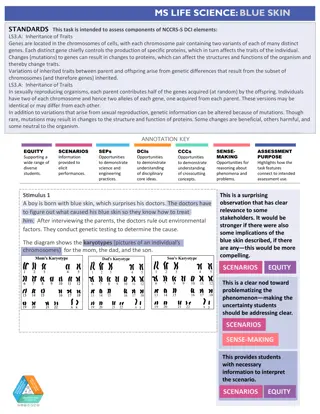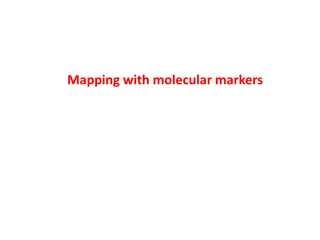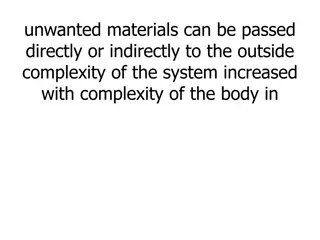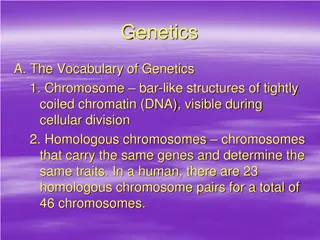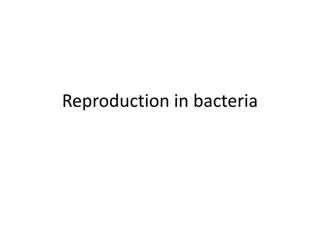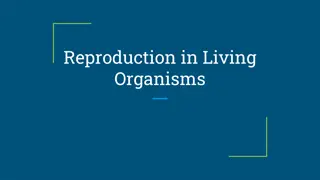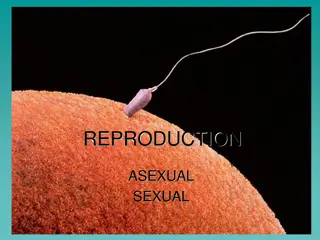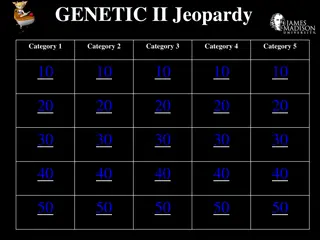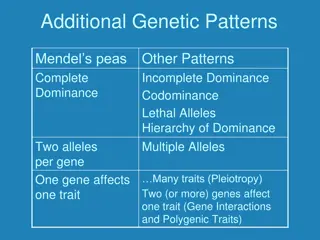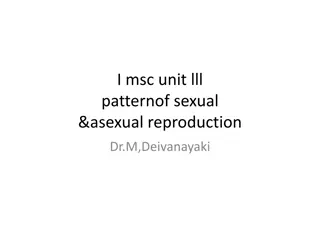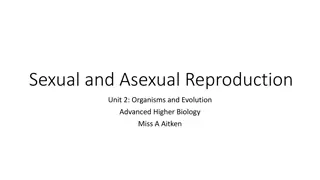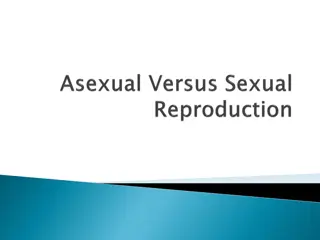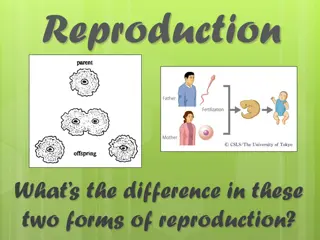Genetic Inheritance and Reproduction
Delve into the world of genetic inheritance and reproduction through topics such as gametes, fertilization, allele definition, genotype versus phenotype, dominant versus recessive traits, and the process of sexual reproduction. Explore how genetic information is passed on from parents to offspring, the formation of gametes, and the significance of chromosomes in determining traits and sex in humans.
Download Presentation

Please find below an Image/Link to download the presentation.
The content on the website is provided AS IS for your information and personal use only. It may not be sold, licensed, or shared on other websites without obtaining consent from the author.If you encounter any issues during the download, it is possible that the publisher has removed the file from their server.
You are allowed to download the files provided on this website for personal or commercial use, subject to the condition that they are used lawfully. All files are the property of their respective owners.
The content on the website is provided AS IS for your information and personal use only. It may not be sold, licensed, or shared on other websites without obtaining consent from the author.
E N D
Presentation Transcript
GENETIC INHERITANCE
Learning Outcomes At the end of this topic you should be able to 1.Give a definition for a gamete 2.Outline the process gamete formation 3.Give the function of gamete in sexual reproduction 4.Define fertilisation 5.Define allele 6.Differentiate between the terms homozygous and heterozygous
Learning Outcomes (cont.) At the end of this topic you should be able to 6. Differentiate between genotype and phenotype 7. Differentiate between dominant and recessive 8. Show the inheritance to the F1 generation in a cross involving: Homozygous parents Heterozygous parents Sex determination Show the genotypes of parents, gametes and offspring
Sexual Reproduction Involves two parents Each parent makes reproductive cells - called gametes
Male Female Sperm Producing Cell Diploid Nucleus Ovum Producing Cell Diploid Nucleus Parent Nucleii Meiosis Ovum Sperm Haploid Nucleus Haploid Nucleus Fertilisation Zygote Diploid Nucleus
Outline of Fertilisation Gametes join together by fertilisation Form a diploid zygote This develops into an embryo Eventually into a new individual New individual resembles both parents but is not identical to either
What are Gametes? Reproductive Cells Formed by meiosis Contain single sets of chromosomes - haploid Capable of fusion to form zygote - diploid Zygote contains genetic information of both gametes
Learning Check 1. What are reproductive cells called? 2. Where are they found? 3. Are they haploid or diploid cells? 4. How are they formed? 5. What is a zygote?
Human Chromosomes We have 46 chromosomes, or 23 pairs. 44 of them are called autosomes and are numbered 1 through 22. Chromosome 1 is the longest, 22 is the shortest. The other 2 chromosomes are the sex chromosomes: the X chromosome and the Y chromosome. Males have and X and a Y; females have 2 X s: XY vs. XX.
Male Karyotype Extracted image from http://www.genome.gov/glossary/resources/karyotype.pdf
Female Karyotype http://www.ucl.ac.uk/~ucbhjow/b200/karyotype.html
Sex Determination The basic rule: If the Y chromosome is present, the person is male. If absent, the person is female.
Meiosis the X and Y chromosomes separate and go into different sperm cells: the sperm carry the X and the other half carry the Y. All eggs have one of the mother s X chromosomes The Y chromosome has the main sex- determining gene on it, called SRY
Sex Determination About 4 weeks after fertilization, an embryo that contains the SRY gene develops testes, the primary male sex organ. The testes secrete the hormone testosterone. Testosterone signals the other cells of the embryo to develop in the male pattern.
Learning Check 1. How many pairs of chromosomes does a human somatic cell have? 2. Which pair of chromosomes determines the sex of the offspring? 3. If you are male what does chromosome pair number 23 look like? 4. If you are female what does chromosome pair number 23 look like?
Genetics The study of heredity. Gregor Mendel (1860 s) discovered the fundamental principles of genetics by breeding garden peas.
Genetic Terms - Alleles Alternative forms of genes. Units that determine heritable traits. Dominant alleles (TT - tall pea plants) a. homozygous dominant Recessive alleles (tt - dwarf pea plants) a. homozygous recessive Heterozygous (Tt - tall pea plants)
Phenotype Outward appearance Physical characteristics Examples: 1. 2. tall pea plant dwarf pea plant
Genotype Arrangement of genes that produces the phenotype Example: 1. tall pea plant TT = tall (homozygous dominant) 2. dwarf pea plant tt = dwarf (homozygous recessive) 3. tall pea plant Tt = tall (heterozygous)
Punnett square A Punnett square is used to show the possible combinations of gametes.
Learning Check 1. What is genetics? 2. What is an allele? 3. What is the difference between phenotype and genotype? 4. What is a punnett square used for?
Breed the P generation tall (TT) vs. dwarf (tt) pea plants T T t t
tall (TT) vs. dwarf (tt) pea plants T T produces the F1 generation Tt Tt t Tt Tt t All Tt = tall (heterozygous tall)
Breed the F1 generation tall (Tt) vs. tall (Tt) pea plants T t T t
tall (Tt) vs. tall (Tt) pea plants T t produces the F2 generation Tt TT T 1/4 (25%) = TT 1/2 (50%) = Tt 1/4 (25%) = tt Tt tt t 1:2:1 genotype 3:1 phenotype
Monohybrid Cross A breeding experiment that tracks the inheritance of a single trait. Mendel s principle of segregation a. pairs of genes separate during gamete formation (meiosis). b. the fusion of gametes at fertilization pairs genes once again.
Homologous Chromosomes eye color locus B = brown eyes eye color locus b = blue eyes This person would have brown eyes (Bb) Paternal Maternal
Meiosis - eye color B sperm B B Bb haploid (n) b b diploid (2n) b meiosis II meiosis I
Monohybrid Cross Example: BB = brown eyes Bb = brown eyes bb = blue eyes Cross between two heterozygotes for brown eyes (Bb) B b male gametes B Bb x Bb b female gametes
Monohybrid Cross B b 1/4 = BB - brown eyed 1/2 = Bb - brown eyed 1/4 = bb - blue eyed BB Bb B Bb x Bb b Bb bb 1:2:1 genotype 3:1 phenotype
Incomplete Dominance F1 hybrids have an appearance somewhat in between the phenotypes of the two parental varieties. Example:snapdragons (flower) red (RR) x white (rr) R R RR = red flower rr = white flower r r
Incomplete Dominance R R produces the F1 generation Rr Rr r Rr Rr r All Rr = pink (heterozygous pink)
Co-dominance Two alleles are expressed (multiple alleles) in heterozygous individuals. Example: blood 1. type A 2. type B 3. type AB 4. type O = IAIA or IAi = IBIB or IBi = IAIB = ii
Co-dominance Example: homozygous male B (IBIB) x heterozygous female A (IAi) IB IB IAIB IAIB IA 1/2 = IAIB 1/2 = IBi IBi IBi i
Learning Check 1. What is a monohybrid cross? 2. What do the terms homozygous and heterozygous represent? 3. What is the difference between co dominance and incomplete dominance
Practice with Crosses http://www.zerobio.com/drag_gr11/mono.htm http://www.brooklyn.cuny.edu/bc/ahp/MGInv/M GI.Intro.html
Chromosomes and Genetics Chromosomes are long pieces of DNA, with supporting proteins Genes are short regions of this DNA that hold the information needed to build and maintain the body Genes have fixed locations: each gene is in a particular place on a particular chromosome Diploids have 2 copies of each chromosome, one from each parent. This means 2 copies of each gene.
What have you learned? Can you . 1. Define a gamete and understand gamete formation 2. Define fertilisation and sex determination 3. Define allele 4. Differentiate between the terms homozygous and heterozygous 5. Differentiate between genotype and phenotype 6. Differentiate between dominant and recessive 7. Understand incomplete dominance 8. Be able to complete monohybrid crosses and state the genotypes and phenotypes of parents and offspring 9. Understand the 3:1 ratio for heterozygous crosses



